
The Forts
of Truth
Divination is a meta-language—it is a method that we employ in service to our communities whereby we seek the assistance of nature to divine the present and the shades of future events. The systems of divination that were presented to you in the previous chapters—namely, the ogam, plant, and bone oracles—must not be seen as methods of “fortunetelling”; on the contrary, they serve a deeper purpose. Any magician worth his or her own weight is in service to the tribe, and this will naturally include offering counselling and advice, whereby members of the community may seek us out to help them at times when things in their lives are challenging or difficult; others may need clarity, a little encouragement, or a push in the right direction—and sometimes it is difficult to see the woods for the trees. This is when the diviner comes into play. By being impartial we are able to see the wood in the trees. Being outside of a given situation and in tune with the tools of our magic provides us with the ability to help those who seek us out.
There may be times when we ourselves need a little assistance, and by working with oracles and divination tools we employ connection and the use of subtle language to connect to the spirit and to the gods and demigods of Celtica by means of tree, plant, or animal magic.
The unique system of divination I present to you here has been in use for a number of years; it has not been “invented” for the purpose of this book or just for the sake of appearing different. It differs from other divination systems in that its effectiveness is entirely dependent on your connection and experience of the attributions and symbols held within it. The glyph on the facing page arises entirely from the Celtic cultural continuum and offers you a method for casting your tools. Simply throwing a handful of ogam staves onto the ground or onto a tabletop is all well and good, but for it to be effective one needs a point of reference; the following glyph will provide you with this.109
The glyph is based on a journey in search of the cauldron through the island forts of Annwn as presented in the Book of Taliesin poem “The Spoils of Annwn.” In it we witness the perilous adventures of Arthur, his warriors, and Taliesin as they encounter seven challenging forts in the seas of Annwn. In my book From the Cauldron Born, I briefly described this journey and offered an interpretation of the forts and their qualities. 110 The journey through Annwn is indicative of the initiate’s quest through regions of the self, and each fort (or caer in the original language) is representative of the human condition—our coping mechanisms and how they influence and affect our lives. By connecting to these themes and to the symbols created for the individual forts, we are accessing a known storehouse of ancient wisdom and descending into the fabric of mind, body, and spirit in unison. This is the practical act of bringing forth inspiration from the deep, emulating the words uttered in the primary ritual: “The Awen I sing, from the deep I bring it.”
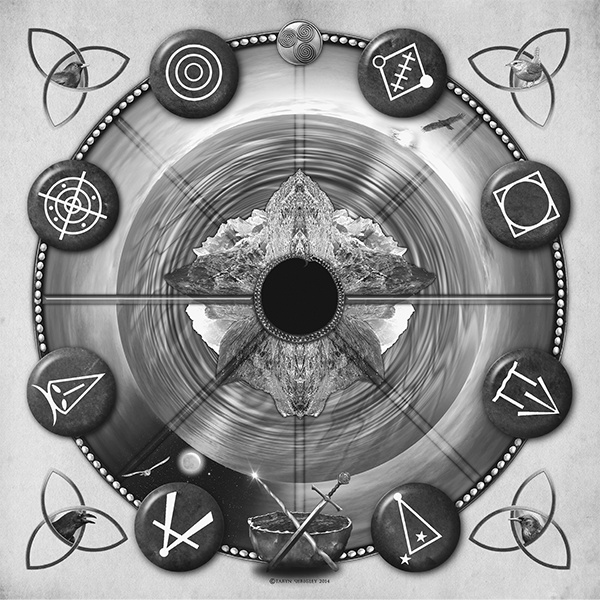
Forts, clockwise from top one o’clock position, and what they govern: Feddwit (communication, thyroid, intoxication), Pedryfan (vitality, immune system, protection), Goludd (passion, pancreas, emotion), Wydr (predestined, thymus, ancestors), Rigor (impulse, adrenals, rigidity), Ochren (reflection, pineal, perception), Vandwy (power, ovaries/testes, creation), and Siddi (illusion, pituitary, control)
And so to the glyph itself—you will note that it is composed of eight divisions, seven of which correspond directly to one of the seven forts of Annwn. The eighth division represents Caer Pedryfan, of which no actual journey is made to; it represents the place of being, your current location. The divisions arise from a central black sphere that represents the potentiality of Annwn; as they radiate outwards, they are subdivided into three sections, each one representing from the center to the outward edge the realms of land, sea, and sky.
The sigils of the forts, which are included in the following caer descriptions, can also be utilized as visionary meditative tools and are not restricted to divination alone—they may be drawn on cards, stones, etc. Focusing the mind on the sigils will allow you to access the attributes and wisdom of each fort in a manner that is purely visionary. They may also be painted or traced on the body for healing purposes in oils or by using minerals, with each sigil corresponding to one of the seven endocrine glands.
In a divinatory sense, the tools of divination—i.e., ogam, the plant and bone oracles, or indeed all three—would be cast onto the glyph drawn on paper, cloth, or another smooth surface; I find that wallpaper lining offers a cheap and effectively large area for the glyph to be drawn on. However, taking the time and effort to create a casting cloth or mat by your own creative means is immensely rewarding.
The position in which the divination tools fall provides the reading. If one or more divisions are empty—if a divinatory tool does not fall on it—that division is disregarded in the reading. If a tool falls beyond the edge of the glyph, it too is disregarded. But if a tool lands in, for example, the sky and land realms of Caer Wydr, one would also take note of the empty realm, sea, in that its quality may be required to resolve or bring clarity to the situation at hand.
The realms represent the following attributions:
Land: physicality, the present, here and now, material affairs
Sea: emotions, passion, vocations, fluidity, movement
Sky: aspirations, un-manifest, concepts in motion without form, spirituality
Annwn: potentiality, the seed of movement, concepts and ideas,
the unknown
Depending on what divinatory tool falls within each realm, the above interact with the fort divisions, giving further depth and meaning to your readings, based entirely on the Celtic cultural continuum. The fort sigils and their attributes are as follows:
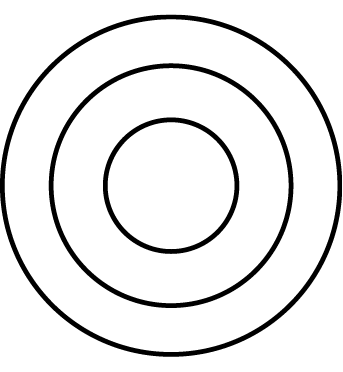
Caer Siddi:
The Fort of the Mound
Three flaming circles of illusion surround the fort. It equates to the pituitary gland of the human body.
Attributions
This is our assumed earthly state, the point from where we make our initial assessment of the world around us, even if our view is obscured or clouded by judgement or preconception. It is the place of illusion, for it will do anything within its power to retain the status quo. Its purpose is to remain steadfast and keep us in the illusion that it knows best. It is the seat of influence, and its power has the ability to convince all the forts beneath it that it is the only truth. It is extremely convincing and can lock us into habitual patterns of repetition. Our clarity of mind comes from this place; we may be imprisoned here and held by the heavy chains of illusion, but to acknowledge its illusionary nature is to lessen its power over us, thus allowing it to become the place of the fire in the head. Its dictatorlike quality is not one gained from malice but one that simply strives to keep everything just as they are. It is simultaneously protective and restrictive.
A divinatory tool that falls within this division represents the status quo, what is illusionary or habitual. This is the place that we know the best, and, however illusionary, we may be secure in our insecurities and will do anything to prevent its walls from crumbling. If the bone of rat were to fall onto the sky realm of Caer Siddi in a reading where the question was in relation to clarity within relationships, it would imply that the person concerned, while extremely devoted, may have their own intangible reasons for taking advantage of the situation and perhaps of the querent to maintain the status quo. It would imply that the emotional and physical needs of the person involved may be cloudy, undefined—they may have lost their way and, believing themselves to be doing what is best, their actions may come across as sly or cunning.
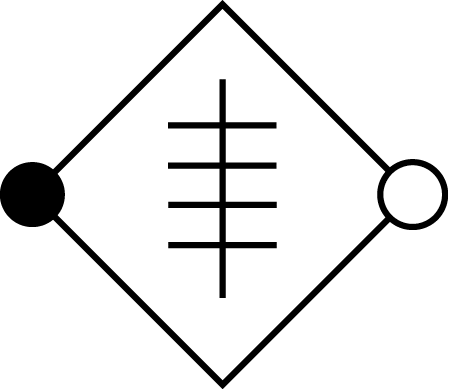
Caer Feddwit:
The Fort of Mead Intoxication
The ogam symbol for poplar (aspen), the tree of insight, expression, and communication, is captured within the square of Caer Pedryfan, the place of being. The dark and full moon sit on either side to display the polarity of our own ability to express and communicate. It equates to the thyroid and parathyroid glands of the human endocrine system.
Attributions
This is the place of communication and the manner by which we express ourselves outwardly to the world, and by proxy the way which we interact and engage with it. Our words can soothe and bring pleasure, comfort, and encouragement; they can also cripple and destroy. Caer Feddwit’s qualities are those of nourishment and sustenance; it is the place where we express our inner environment. It is how we present ourselves vocally and affect the world around us by the action of words. Speech can nourish, but it can also poison; its effect on the world around us and on our own internal physiological environment can be profoundly affecting. What sustains us can also poison us. Everything that we find pleasurable and intoxicating in life is expressed through this fortification.
A divinatory tool that falls onto this division is indicative of our communicative position and the manner in which we wish to be perceived. This is the place of expression and our ability to nourish ourselves and others. If, for example, nettle fell onto the land realm of Caer Feddwit and the ogam stave for bramble fell in the realm of sea, it would demonstrate that the situation the querent is facing is causing them some annoyance, and this irritation may well be arising from too much emotional connection; distance may be needed. A touch of sky is required in order to allow the querent to objectively look inwards to discover the reason why the situation is annoying them so much.
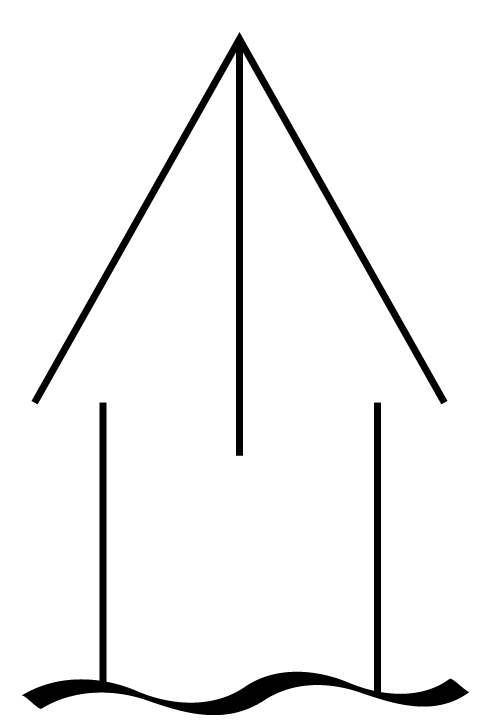
Caer Goludd:
The Fort of Impediment
The threshold between the worlds, liminality; an arrow points up from the pillars of land and sky that sit atop the sea. It points to gain, growth, and riches, and it is also representative of Awen shining with passion and inspiration. It equates to the endocrine function of the pancreas.
Attributions
Caer Goludd represents what we feel in the pit of our stomach. The fort of impediment is a fickle place, for we may sense our anger rise from here, shattering the windows of the forts, cracking the walls or its turrets, and yet it is the seat of our creativity. This fort represents the riches we enjoy in life and those things that make us feel good about ourselves. But in a compromised situation, we may feel the claw of envy, jealousy, or anger rise from the center of our being, gathering momentum as it rises to burst forth through the portal of Caer Feddwit above. We are easily frustrated in here and may feel that sometimes we are fighting a losing battle. Caer Goludd is that secret place within us that defines how we learn, what we learn, and what influences us; our vanity comes from here, as does our smugness and snobbery. The first stirrings of lust and carnality rise within the heat of this place; as sugars burn through the blood, so too does this place cause the screaming of our sex hormones to raise their heads and demand attention. This is the seat of our emotions; it is the vice that grips the core when we are in grief, anguish, or despair. The dizzying heights of elation and happiness can be felt here, as can the butterflies in the stomach when faced with the rush of attraction or anticipation.
If a divinatory tool falls onto this division, it is indicative of our passions—our emotional stability or instability, as the case may be. It is the origin of expression. If a querent needed insight into why a certain project feels hindered or is not meeting their expectations and the bone of cat is cast onto the sea realm of Caer Goludd, it would imply that the emotional connection the querent has to the material is one-sided, and this passion may appear superior and self-inflated. Total absorption in the project may have resulted in the querent appearing aloof and unapproachable. The answer to this would be to bring these aspects down to land and ground them in foundation, depending on what tools are falling on other parts of the glyph.
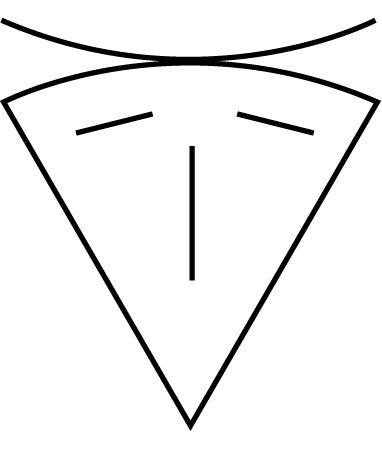
Caer Ochren:
The Fort of Edges
The beast with the silver head, with the moon shining between its horns. It equates to the pineal gland.
Attributions
This is the fort of reflections, the great tower of mirrors. It appears as a mirrored enclosure, its walls silvered; it is the place where we see ourselves—or, rather, our reflection. Within its walls we see reflected what we want to see, not necessarily what is actually there. We may be pleased or displeased by our own image, and yet we may not realize that a mirrored reflection is not a true representation. The image is reversed; it is not how the world sees us. Its lunar associations teach us about the nature of perception. Remember that the moon does not shine by its own light, however beautiful it is; it shines by means of reflected light. Its true nature may well be hidden in its dark face that never sees the light of the sun; what we see is simply an illusion of mirrored or reflected light. We may judge ourselves harshly within the confines of Caer Ochren, for it is the seat of perception and effectiveness. We may conform to the standards and expectations of another here. The limitation of intelligence may impede our experiences, and we are in danger of becoming overanalytical within its mirrored courtyards.
If a tool is cast onto this division it is indicative of perception, intelligence, logic, rationality, and the manner by which we physically interact with the world. If the plant symbol for rosemary were to fall on the land aspect of Caer Ochren in a question where the querent felt that they were being misjudged, it would imply that a time-out is urgently needed. If the ogam symbol for oak fell in the sky realm of the same division, it would imply that the querent has endured too much of a situation that was untenable—the strength of oak would need to be grounded in order to bring rationality and logic to what is being perceived as a problem. Rosemary asks for time out to reflect, for temporary separation; oak in sky may have forced the querent into a corner where they feel they must continue to behave or act in a manner that arose out of want rather than necessity.

Caer Vandwy:
The Fort of High Mystery
The glyph incorporates all other forts within its circles, which it intersects with the equal-armed cross. The point where the cross meets implies the origin and answer to mystery. It equates to the ovaries and testes of the endocrine system.
Attributions
This is the place of high mystery, wisdom, and knowledge. Caer Vandwy is the primal driving force of the human experience; it is the seat of reproduction, carnality, and lust. This fort can cause “lust blindness” and cause us to fall into the consuming flames of irrationality and obsession, and yet it is the place where we maintain the continuation of our species. This is the place of spirituality and the way in which we sense and perceive the subtle forces of the universe. It is a place of comparison, conformity, and competition, where we maintain or become victims of our vanity. Our confidence and self-esteem, so intricately tied to our sexual drive, sing from this place, but so too does inexperience and the inability to conceptualize.
For a tool to fall onto this division implies that the actual foundation of all that you are familiar with is being questioned. Issues of sexuality, love, and relationships come to the fore in this fort. If the ogam stave for yew fell in land and the bone of raven in the realm of sea in relation to the querent’s sense of spiritual development, it would imply that a situation must end for transformation to be grounded. Body and spirit must unite; raven in sea would imply that the courage to create this change is being muddied by waves of emotion. The querent needs to ground in spirit and evaluate the need for transformation; raven may imply that too much emotion is pushing out the use of the intellect. Bring heart and mind together in unison.
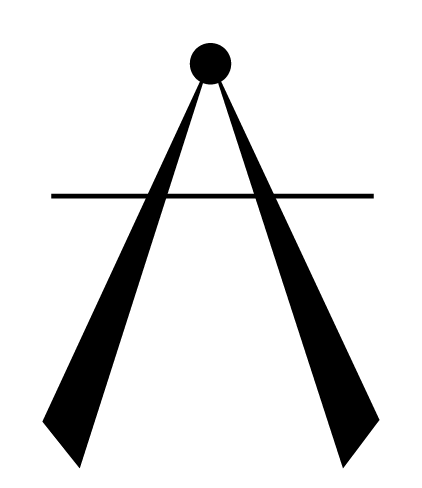
Caer Rigor:
The Fort of Rigidity
Balance and imbalance; the circle represents the self pivoted above the line of balance.
Attributions
This is a difficult fort. In a divinatory sense, any tools that fall within its realms will be challenging and possibly painful. It is the place of stumbling, rigidity, hardness, falling, and the ego. It dictates the manner by which we develop coping mechanisms that deal and make sense of the other forts. These may be appropriate or inappropriate. It is the most dangerous fort; here we can fall into the “I’m not good enough” or the “I’m right and you’re wrong” mentality. We can become immovable and stubborn here. Our insecurities and those things that threaten us are realized here; it is the place we are most threatened and we ourselves may threaten. The qualities of Rigor are many, and it can propel us into action with sheer determination. It is a constructive place where personal strengths can be utilized effectively, and yet its opposite side can be immensely destructive.
For the division of Rigor to be selected by a divinatory tool implies that the situation may be inflexible, rigid, petrified, or cold. It points to the manner by which we are dealing or coping with the situation at hand. If the bone of rabbit were to fall on the sky realm of Caer Rigor when the question asked was in relation to a new project and anxiety therewith, it would imply that although a degree of trepidation is healthy and will avoid unnecessary risk taking, the querent may be too easily unnerved and may be overreaching their ambitions into intangibility, then panicking when things do not go according to plan. The quality of rabbit needs to be pulled down to sea and bridge the gap between what is tangible and what is ethereal. The querent may want to appear to be in full control, and yet their anxieties are too overwhelming; they are reaching too far, too quickly. Pull back.
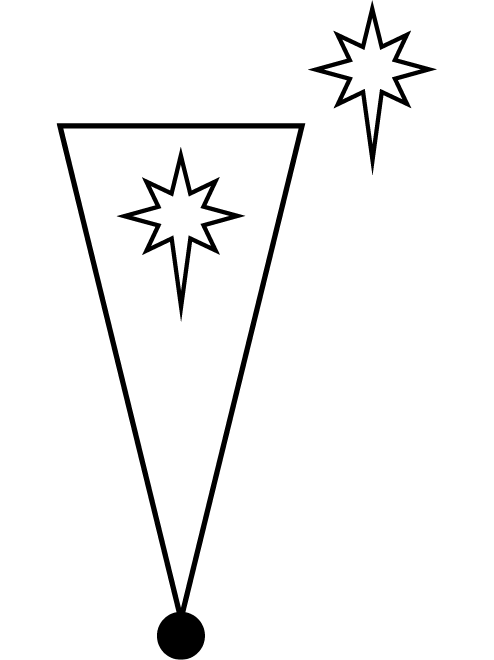
Caer Wydr:
The Fort of Glass
The sigil represents a shard of glass reflecting the constellation of the Great Bear, Arthur (arth = bear in Welsh), which points to the place of being.
Attributions
This epitomizes inherited patterns that we have no control over and sets the scene for the remainder of our human lives. However determined our attempts to communicate with it are, we simply cannot; it is voiceless and will not permit itself to be swayed or influenced. It is the result of thousands of generations of genetic predisposition and inheritance. Caer Wydr expresses the fact that you are the sum total of all that has been before you. This function may appear mysterious and perhaps unfair, and yet it is a vital aspect of our human experience—we are influenced by the past, by blood and by memory, and this is held within the vast halls of Caer Wydr. Its influence can be seen within every subsequent fort. If Caer Siddi’s illusion can be perceived, we must then also see through the walls of Caer Wydr, for its glass surface may obscure what lies beyond its borders. Glass is a peculiar substance; we may believe that we can see right through it, but light, shadow, and reflection can alter the view, preventing us from actually seeing what is there.
For a tool to fall onto this division in a reading would imply patterns of behavior, of ancestry and heritage and what we perceive as the foundations of our life—family, profession, relationships, etc.—are being addressed. If alder was cast onto the land realm of Caer Wydr and the plant oracle for mistletoe in sky in relation to a relationship crisis, it could imply that the foundation of the relationship has changed, and yet the behavior of those involved has not developed or evolved appropriately. Mistletoe in sky suggests that there is the potential for fertility and inspiration, but the absence of anything in sea implies that emotional separation may have ensued from complacency.
Caer Pedryfan:
The Place of Being
A four-walled enclosure surrounds the circle of Annwn.
Attributions
This fort represents all that is physical, which may include but is not exclusive to your home, your body, and to all that you hold familiar and knowable. Anything that may be cast onto this division is indicative of your place in the here and now; therefore, if the question is in relation to the home and the ogam stave that represents rowan falls within its realm of sky, it would imply that the issues at hand are lofty and intangible, and may well be figments of your own imagination. Rowan would imply that insight and the ability to look within to bring the issues from the intangibleness of sky and into the form of land before is necessary before this issue will resolve itself. However, finding blackthorn in the realm of sea may imply that something or someone is attempting to take control of the situation by influence of coercion, instigated by an emotional and possibly irrational reaction.
A Sample Reading
Beth is a mother of three older children and works full-time. She is a talented artist and has recently been asked to offer workshops and talks on sacred art. She asked the oracle if she should risk taking time out from work and her family commitments to go part-time in order to pursue her artistic talents.
From a box containing a mix of bones, plant coins, and ogam staves, she randomly selected nine divinatory tools, held them in her closed hands while pondering the question, and allowed them to fall onto the divination cloth.
The bone of hare fell directly onto the circle of Annwn, demonstrating that the potential for this situation to arise is already forming in the sheer potential of Annwn and bubbling up to affect Beth’s life; this is not simply a dream. Hare indicates that the time for causing this to be manifest on the physical plane is imminent. Hare is subtle, powerful, enigmatic, sensitive, and in tune with the subtle; this implies that Beth needs to be reliant on more than her physical senses to judge this.
The ogam for birch fell onto the land aspect of Caer Goludd, which implies that Beth is intensely passionate about this project, and it has imbued within her the sense that this could create a new beginning and colonize a new era of her life with new projects and possibilities. However, the presence of the ogam for blackthorn crossing from the sea realm of Caer Goludd into land indicates that there is some emotional displacement going on here; she needs to control the situation and think logically about the consequences of her action. Blackthorn may indicate that she is reacting with too much emotion, and this may cloud her vision a little. She needs to have the passion of Goludd, but she also needs to prevent it from running away with itself and becoming unruly or resulting in uncalculated risks.
Hawthorn in the land aspect of Caer Siddi indicates that she may well be overanxious about the risks to the material, work, and family aspects of her life. Hawthorn presents challenges, yes, but she may be worrying unnecessarily about what impact this project will have on the physicality of her professional situation. Her children are grown up; although living at home, they are financially independent, and yet Beth is maintaining the apron strings instead of bringing some rational emotions (sea) into the mix, with a clear idea of her aspirations (sky). With her talents being recognized, she is still maintaining the illusion that the money she earns is vital to the wellness of her domestic life, but hawthorn is suggesting that this is not the case.
Agrimony in the realm of sea in Caer Feddwit is reiterating the new beginning of birch in Goludd; this is the vocalization and the outward expression of that passion made manifest. She needs to liberate this impulse and give it voice, combining the feeling aspect of the place of communication with the foundation aspect of her passions in Caer Goludd. The absence of any tool in the realms of land and sky of Feddwit are indicative of the fact that emotional balance is key; do not be overcautious to maintain material security, and do not be flaky in your aspirations and have unrealistic dreams. As an artist, emotion in her work will touch people deeply.
Deer fell in the sky realm of Ochren and fennel in the land realm of the same division. Again, this is reiterating the need for emotional rationalization and stability to enable this situation to progress with positive results. These two aspects are in relation to the way Beth sees herself; naturally she is anxious and nervous to make such a change in her life after years of the status quo. Self-confidence has always been an issue, but she has new insights gained from experience and the situation would not have prevented itself had it been all sky; it has been offered because those in the position to realize her talents are able to perceive its far-reaching effects (sky) and its grounded aspect (land).
Two items fell beyond the border of the glyph and were disregarded. To look at the whole picture, the indication was that Beth has been overanxious and has some fears of changing the ebb and flow of her life, yet she is excited about the changes. All indications are in favor of her taking this new project and making a calculated risk that will no doubt pay off in the long run.